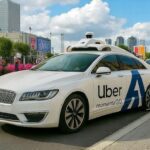Uber reported an impressive 18% year-over-year increase in gross bookings, reaching $42.8 billion in the first quarter of 2025. However, the ride-hailing giant’s revenue of $11.53 billion fell short of analyst expectations of $11.62 billion, causing its shares to decline by over 4% following the earnings announcement.
The company’s performance reflects a complex balance between growth and strategic investments, particularly in autonomous vehicle (AV) technology. Despite beating earnings per share expectations at $0.83, the revenue miss has raised questions about short-term growth sustainability in the market.
CEO Dara Khosrowshahi has positioned autonomous vehicle technology as Uber’s primary strategic focus, describing it as “the single greatest opportunity ahead for Uber.” The company has established significant partnerships with automotive industry leaders, including Volkswagen and Alphabet’s Waymo, to advance its AV initiatives.
A notable development is Uber’s strategic alliance with Volkswagen, which will introduce thousands of all-electric, fully autonomous ID.Buzz AD vehicles in Los Angeles. Commercial operations are scheduled to commence in 2026, following necessary testing and regulatory approvals.
The company’s autonomous technology development encompasses both passenger transport and goods delivery services. Uber is investing in advanced technologies, including machine learning models for sensor processing, LIDAR object classification, and simulation tools for testing autonomous systems in critical safety scenarios.
While the Mobility and Delivery segments showed robust growth, Uber’s freight division experienced a marginal decline, with bookings dropping 1% year-over-year. Looking ahead, the company projects second-quarter gross bookings between $45.75 billion and $47.25 billion, with adjusted EBITDA forecasted between $2.02 billion and $2.12 billion.
Market analysts suggest that the revenue shortfall highlights the challenges of balancing substantial investments in autonomous technology whilst maintaining steady revenue growth. The company’s partnerships with automotive and technology leaders demonstrate its commitment to transforming urban transportation fundamentally.
The success of Uber’s autonomous vehicle strategy could revolutionise the ride-hailing and delivery sectors by reducing operational costs and enabling round-the-clock service availability. However, this transformation depends heavily on regulatory clearance, technological advancement, and public acceptance.
As Uber continues its transition towards autonomous operations, the company’s Q1 2025 results reflect both the opportunities and challenges ahead. While the 18% increase in trips demonstrates strong platform demand, the focus on autonomous vehicle development represents a significant long-term investment in reshaping the future of global urban mobility.
News Source: https://www.cnbc.com/2025/05/07/uber-uber-q1-2025-earnings.html









